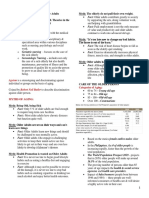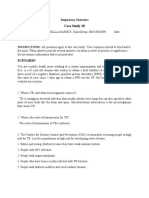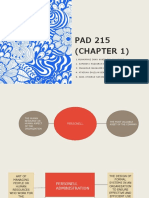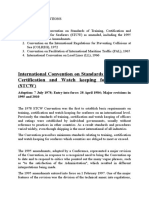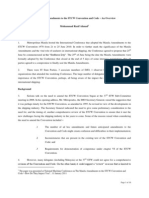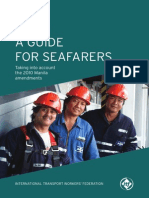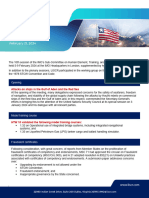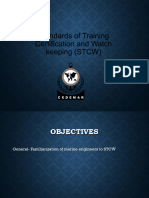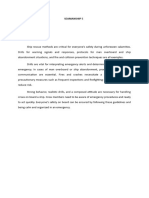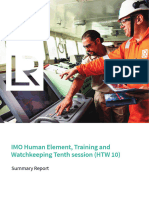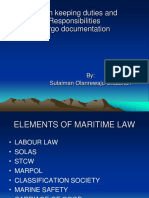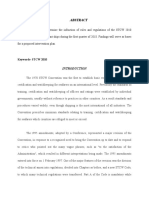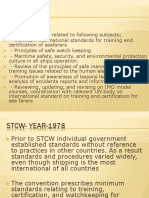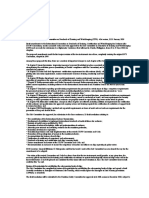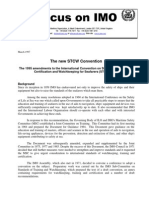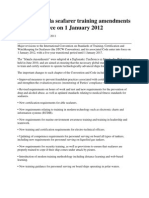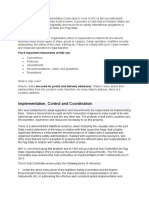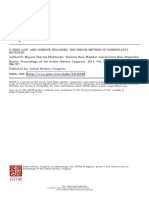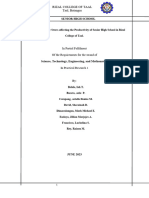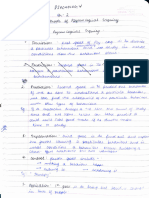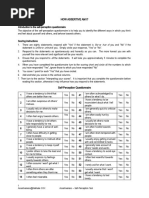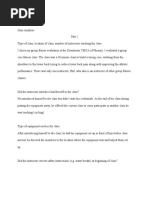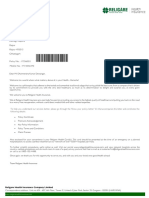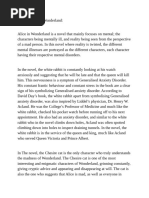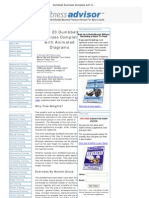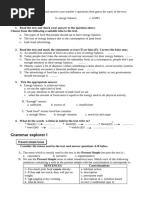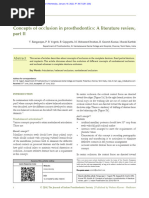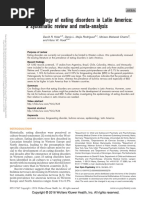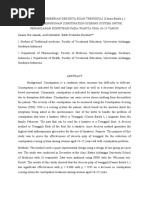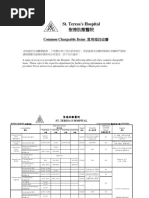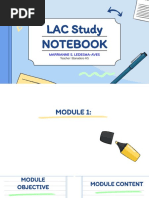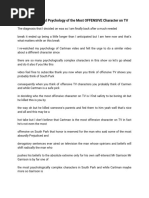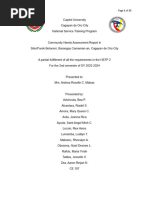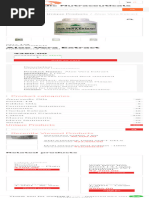STCW
STCW
Uploaded by
NguyenTienDatCopyright:
Available Formats
STCW
STCW
Uploaded by
NguyenTienDatOriginal Title
Copyright
Available Formats
Share this document
Did you find this document useful?
Is this content inappropriate?
Copyright:
Available Formats
STCW
STCW
Uploaded by
NguyenTienDatCopyright:
Available Formats
The 1978 STCW Convention was the first to establish basic requirements on training,
certification and watchkeeping for seafarers on an international level. Previously
the standards of training, certification and watchkeeping of officers and ratings
were established by individual governments, usually without reference to practices
in other countries. As a result standards and procedures varied widely, even though
shipping is the most international of all industries.
The Convention prescribes minimum standards relating to training, certification and
watchkeeping for seafarers which countries are obliged to meet or exceed.
The 1995 amendments, adopted by a Conference, represented a major revision of the
Convention, in response to a recognized need to bring the Convention up to date and
to respond to critics who pointed out the many vague phrases, such as "to the
satisfaction of the Administration", which resulted in different interpretations
being made.
The 1995 amendments entered into force on 1 February 1997. One of the major
features of the revision was the division of the technical annex into regulations,
divided into Chapters as before, and a new STCW Code, to which many technical
regulations were transferred. Part A of the Code is mandatory while Part B is
recommended.
Dividing the regulations up in this way makes administration easier and it also
makes the task of revising and updating them more simple: for procedural and legal
reasons there is no need to call a full conference to make changes to Codes.
Another major change was the requirement for Parties to the Convention are required
to provide detailed information to IMO concerning administrative measures taken to
ensure compliance with the Convention. This represented the first time that IMO had
been called upon to act in relation to compliance and implementation - generally,
implementation is down to the flag States, while port State control also acts to
ensure compliance. Under Chapter I, regulation I/7 of the revised Convention,
Parties are required to provide detailed information to IMO concerning
administrative measures taken to ensure compliance with the Convention, education
and training courses, certification procedures and other factors relevant to
implementation.The information is reviewed by panels of competent persons,
nominated by Parties to the STCW Convention, who report on their findings to the
IMO Secretary-General, who, in turn, reports to the Maritime Safety Committee (MSC)
on the Parties which fully comply. The MSC then produces a list (the so called
"white list") of "confirmed Parties" in compliance with the STCW Convention.
STCW Convention chapters
Chapter I: General provisions
Chapter II: Master and deck department
Chapter III: Engine department
Chapter IV: Radiocommunication and radio personnel
Chapter V: Special training requirements for personnel on certain types of ships
Chapter VI: Emergency, occupational safety, medical care and survival functions
Chapter VII: Alternative certification
Chapter VIII: Watchkeeping
The STCW Code
The regulations contained in the Convention are supported by sections in the STCW
Code. Generally speaking, the Convention contains basic requirements which are then
enlarged upon and explained in the Code.Part A of the Code is mandatory. The
minimum standards of competence required for seagoing personnel are given in detail
in a series of tables. Part B of the Code contains recommended guidance which is
intended to help Parties implement the Convention. The measures suggested are not
mandatory and the examples given are only intended to illustrate how certain
Convention requirements may be complied with. However, the recommendations in
general represent an approach that has been harmonized by discussions within IMO
and consultation with other international organizations.
The Manila amendments to the STCW Convention and Code were adopted on 25 June 2010,
marking a major revision of the STCW Convention and Code. The 2010 amendments are
set to enter into force on 1 January 2012 under the tacit acceptance procedure and
are aimed at bringing the Convention and Code up to date with developments since
they were initially adopted and to enable them to address issues that are
anticipated to emerge in the foreseeable future.
Amongst the amendments adopted, there are a number of important changes to each
chapter of the Convention and Code, including:
· Improved measures to prevent fraudulent practices associated with
certificates of competency and strengthen
the evaluation process (monitoring of Parties' compliance with the
Convention);
· Revised requirements on hours of work and rest and new requirements for the
prevention of drug and alcohol
abuse, as well as updated standards relating to medical fitness standards for
seafarers;
· New certification requirements for able seafarers;
· New requirements relating to training in modern technology such as
electronic charts and information systems
(ECDIS);
· New requirements for marine environment awareness training and training in
leadership and teamwork;
· New training and certification requirements for electro-technical officers;
· Updating of competence requirements for personnel serving on board all types
of tankers, including new
requirements for personnel serving on liquefied gas tankers;
· New requirements for security training, as well as provisions to ensure that
seafarers are properly trained to
cope if their ship comes under attack by pirates;
· Introduction of modern training methodology including distance learning and
web-based learning;
· New training guidance for personnel serving on board ships operating in
polar waters; and
· New training guidance for personnel operating Dynamic Positioning Systems.
You might also like
- NCM 114 Care For Older Adults MODULE 1Document5 pagesNCM 114 Care For Older Adults MODULE 1Meryville Jacildo100% (3)
- STCW History PDFDocument2 pagesSTCW History PDFMohd Hisham RubaniNo ratings yet
- Case Study 18: Respiratory DisordersDocument4 pagesCase Study 18: Respiratory DisordersPremiums of the RoseNo ratings yet
- Pad215 (Chapter 1)Document14 pagesPad215 (Chapter 1)AM110 2C Muhammad Iman Hakim100% (1)
- International Convention On Standards of Training, Certification and Watch Keeping For Seafarers (STCW)Document4 pagesInternational Convention On Standards of Training, Certification and Watch Keeping For Seafarers (STCW)RLINS MADURAINo ratings yet
- International Convention On Standards of Training, Certification and Watchkeeping For Seafarers, 1978Document2 pagesInternational Convention On Standards of Training, Certification and Watchkeeping For Seafarers, 1978ANKUSH YADAVNo ratings yet
- Adoption: 7 July 1978 Entry Into Force: 28 April 1984 Major Revisions in 1995 and 2010 (Latest Amendments AreDocument10 pagesAdoption: 7 July 1978 Entry Into Force: 28 April 1984 Major Revisions in 1995 and 2010 (Latest Amendments Aresukhjit78100% (1)
- International Convention On Standards of Training, Certification and Watchkeeping For Seafarers, 1978Document11 pagesInternational Convention On Standards of Training, Certification and Watchkeeping For Seafarers, 1978rajishrrrNo ratings yet
- A10 11. MGMT 2 STCWDocument22 pagesA10 11. MGMT 2 STCWFrancis JeorgeNo ratings yet
- International Convention On Standards of Training, Certification and Watchkeeping For Seafarers (STCW)Document55 pagesInternational Convention On Standards of Training, Certification and Watchkeeping For Seafarers (STCW)Jeric SorianoNo ratings yet
- 11 STCW ConventionDocument10 pages11 STCW Conventionmariners123No ratings yet
- The Manila Amendments To The STCW Convention and Code - An OverviewDocument10 pagesThe Manila Amendments To The STCW Convention and Code - An OverviewHenrik LindqvistNo ratings yet
- MGMT 2 WEEK7 8 CME Official Layout OriginalDocument12 pagesMGMT 2 WEEK7 8 CME Official Layout OriginalramilsalundagaNo ratings yet
- STCW Code With AmmendamentsDocument3 pagesSTCW Code With AmmendamentsAnonymous ZhXO4DIzNo ratings yet
- 1 STCW OverviewDocument19 pages1 STCW OverviewJosh SebastianNo ratings yet
- STCW Guide EnglishDocument78 pagesSTCW Guide EnglishBenja87100% (8)
- STCW Guide EnglishDocument78 pagesSTCW Guide EnglishANDREASBOUL100% (3)
- STCW CodeDocument10 pagesSTCW CodeTo-trio Stouges100% (1)
- Liscr Imo HTWDocument4 pagesLiscr Imo HTWBtwins123No ratings yet
- STCWDocument37 pagesSTCWJohn Mithu80% (5)
- STCW'2010Document4 pagesSTCW'2010haidirNo ratings yet
- stcw codeDocument27 pagesstcw codeAlejandro Sanchez ArroyoNo ratings yet
- STCW Guide EnglishDocument78 pagesSTCW Guide EnglishOana ToganNo ratings yet
- STCWDocument27 pagesSTCWOladokun Sulaiman Olanrewaju93% (14)
- STCW Implementation Dec 04Document18 pagesSTCW Implementation Dec 04anajayahoNo ratings yet
- LancelotlotDocument5 pagesLancelotlotAllyza JordanNo ratings yet
- Standards and Regulations For Engine Watch KeepingDocument14 pagesStandards and Regulations For Engine Watch KeepingJustin CaliguiaNo ratings yet
- HTW 10 Summary Report - CleanedDocument6 pagesHTW 10 Summary Report - Cleanedashfaq261sailorNo ratings yet
- Lecture 6 - STCWDocument25 pagesLecture 6 - STCWMazen AymanNo ratings yet
- International Maritime Standards and National Maritime LegislationsDocument9 pagesInternational Maritime Standards and National Maritime LegislationsPiche Parcon Dayatan100% (1)
- Watchkeepingdutiesresponsibilitiesandcargodocumentation 121110020409 Phpapp02 PDFDocument17 pagesWatchkeepingdutiesresponsibilitiesandcargodocumentation 121110020409 Phpapp02 PDFSamir Alshaar100% (2)
- APAformat UnfinishedDocument10 pagesAPAformat Unfinishedliezl ann g. valdezNo ratings yet
- STCWDocument37 pagesSTCWAbdul Hafiz80% (5)
- STCWDocument37 pagesSTCWAbdul HafizNo ratings yet
- Isplaying The Only PostDocument2 pagesIsplaying The Only PostAnang Ma'rufNo ratings yet
- Happy Birthday BoiDocument7 pagesHappy Birthday BoiAllyza JordanNo ratings yet
- MGMT 2 Week 9&10Document2 pagesMGMT 2 Week 9&10DarkxeiDNo ratings yet
- STCW Guide English 01 January 2017Document78 pagesSTCW Guide English 01 January 2017662724100% (2)
- Focus On ImoDocument15 pagesFocus On ImoLeo ThomasNo ratings yet
- Flag State RULESDocument75 pagesFlag State RULESAgar Sail100% (1)
- Enhancement of STCW ObjectivesDocument5 pagesEnhancement of STCW ObjectivessameerNo ratings yet
- MGMT 2 WEEK10 CME Official Layout OriginalDocument20 pagesMGMT 2 WEEK10 CME Official Layout OriginalramilsalundagaNo ratings yet
- stcw7 Circ24 Rev1Document4 pagesstcw7 Circ24 Rev1gongaxNo ratings yet
- STCW Manila AmendmentsDocument2 pagesSTCW Manila AmendmentsAbu Bakar Siddique SuridNo ratings yet
- MLC 2006Document12 pagesMLC 2006maneeshjha9368No ratings yet
- STCW 7-Circ 24Document4 pagesSTCW 7-Circ 24Evi Anastasiou100% (1)
- STCWDocument3 pagesSTCWvirendra302No ratings yet
- MNGT 2 Week 12Document12 pagesMNGT 2 Week 12Jezel GringcoNo ratings yet
- MGMT 2 WEEK11 CME Official Layout OriginalDocument20 pagesMGMT 2 WEEK11 CME Official Layout OriginalramilsalundagaNo ratings yet
- Technical InformationDocument6 pagesTechnical Informationpapaki2No ratings yet
- IMO Istruments Implementation CodeDocument7 pagesIMO Istruments Implementation CodePraveen AbisakeNo ratings yet
- Imo Conventions 1. SOLAS: An IntroductionDocument35 pagesImo Conventions 1. SOLAS: An IntroductionBisrat100% (2)
- STCW Convention - WikipediaDocument16 pagesSTCW Convention - WikipediaHarel Santos Rosacia100% (1)
- Load Line and STCW CodeDocument13 pagesLoad Line and STCW CodeMegh WadhawanNo ratings yet
- Activity 7 & 8 MGMT 2Document4 pagesActivity 7 & 8 MGMT 2Ramil SalundagaNo ratings yet
- STCW Code JakeDocument19 pagesSTCW Code Jakejake lavarejos100% (1)
- Licensing Process for the Construction, Commissioning and Operation of Nuclear Power PlantsFrom EverandLicensing Process for the Construction, Commissioning and Operation of Nuclear Power PlantsNo ratings yet
- Regulatory Oversight of Ageing Management and Long Term Operation Programme of Nuclear Power PlantsFrom EverandRegulatory Oversight of Ageing Management and Long Term Operation Programme of Nuclear Power PlantsNo ratings yet
- Carbon Offsetting in International Aviation in Asia and the Pacific: Challenges and OpportunitiesFrom EverandCarbon Offsetting in International Aviation in Asia and the Pacific: Challenges and OpportunitiesNo ratings yet
- Caderno deDocument46 pagesCaderno denmariarayssaNo ratings yet
- Mindfulness Skills ManualDocument16 pagesMindfulness Skills ManualGeorge ADEHNo ratings yet
- Religious IdentityDocument233 pagesReligious IdentityPrabhjot SinghNo ratings yet
- BSBLDR511 Student AssessmentsDocument31 pagesBSBLDR511 Student AssessmentsManish Uprety50% (2)
- This Content Downloaded From 14.139.187.130 On Thu, 16 Sep 2021 05:51:19 UTCDocument11 pagesThis Content Downloaded From 14.139.187.130 On Thu, 16 Sep 2021 05:51:19 UTCAtmeeya MasikaNo ratings yet
- FinalDocument47 pagesFinalLuchelina FranciscoNo ratings yet
- FinalDocument81 pagesFinalYatharth DateerNo ratings yet
- Adobe Scan 14 Sept 2023Document22 pagesAdobe Scan 14 Sept 2023madhuriprabhakar80No ratings yet
- Assertiveness - Self Perception Test - With AnswersDocument6 pagesAssertiveness - Self Perception Test - With AnswersstephNo ratings yet
- Gym AnalysisDocument6 pagesGym AnalysistreNo ratings yet
- PDF 17256553 1586590267466Document7 pagesPDF 17256553 1586590267466Lucky TraderNo ratings yet
- Task 5 Alice in WonderlandDocument3 pagesTask 5 Alice in Wonderlandfederico.panzavolta2.010No ratings yet
- Slap LesionsDocument44 pagesSlap LesionsmamshivaNo ratings yet
- FieldManual A Field Manual For Collection of Specimens To Enhance Diagnosis of Animal Diseases PDFDocument150 pagesFieldManual A Field Manual For Collection of Specimens To Enhance Diagnosis of Animal Diseases PDFrazadrpkNo ratings yet
- Dumbbell Exercises Complete With Animated DiagramsDocument7 pagesDumbbell Exercises Complete With Animated DiagramsVasan Srini SNo ratings yet
- Read and Consider SafetyDocument2 pagesRead and Consider SafetyBiba BenyahiaNo ratings yet
- Concepts of Occlusion in Prosthodontics A Literature Review Part 2Document7 pagesConcepts of Occlusion in Prosthodontics A Literature Review Part 2inibuatdaftar101No ratings yet
- Epidemiology of Eating Disorders in Latin America .8Document9 pagesEpidemiology of Eating Disorders in Latin America .8NaiaraNo ratings yet
- 5 KonstipasiDocument9 pages5 Konstipasihasbun abdurrahmanNo ratings yet
- St. Teresa's Hospital 聖德肋撒醫院: Common Chargeable Items 常用項目收費Document27 pagesSt. Teresa's Hospital 聖德肋撒醫院: Common Chargeable Items 常用項目收費Hemkerovner Keresztszegh von Kolowrat-KrakowskyNo ratings yet
- LAC Study NOTESDocument22 pagesLAC Study NOTESMIMOYOUNo ratings yet
- The Complicated Psychology of The Most OFFENSIVE Character On TVDocument22 pagesThe Complicated Psychology of The Most OFFENSIVE Character On TV091945029No ratings yet
- 5 - NAS Questionnaire With Data PrivacyDocument25 pages5 - NAS Questionnaire With Data Privacy2086775No ratings yet
- Aquatic Recreational ActivitiesDocument49 pagesAquatic Recreational Activitiesmaynard pascualNo ratings yet
- Aloe Vera Extract - Vedic NutraceuticalsDocument1 pageAloe Vera Extract - Vedic NutraceuticalsAnjana SaiNo ratings yet
- Coursework FeedbackDocument5 pagesCoursework Feedbackbcnwhkha100% (2)
- Complete Dentures - Extraoral ExamDocument8 pagesComplete Dentures - Extraoral ExamlindaNo ratings yet
